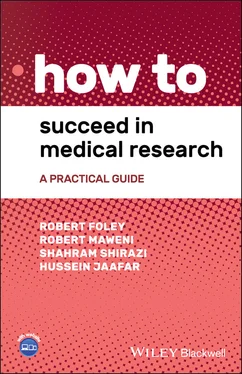Ask senior colleagues if they have read a recent paper on which they have some opinions they would like to share or questions they would like to ask the author. In this way, you can become involved in writing a letter to the editor outlining these points. Letters can often be quite succinct and not take too much time to produce. However, often your mentor will not have the time to write a letter despite having excellent opinions and points on the topic. It is also a good chance for you to practice your writing and literature review.
Case Study 1.1 Letter to the editor [1]
One of my earliest mentors in research once commented that ‘we should all be writing more letters to the editor’. Although it still happens, the concept is much less common than it was previously. It is an excellent opportunity to sum up one's thoughts on an article, to offer an alternative point of view, to ask any pressing questions of the authors, or to disagree with their conclusions. Often a letter to the editor and a reply from the original author can make for very interesting debate. While I was reading on the topic of quality of life in patients with a specific type of brain tumour (an acoustic neuroma), I came across a recently published paper by Lodder and colleagues [2]. I had written a similar paper previously and had read a number of similar papers in the preceding months. I was struck by how the paper and the conclusion focused on the same topic as everyone else. The authors found that patients with an acoustic neuroma had a similar quality of life outcome, whether they underwent treatment with surgery, radiotherapy, or both. However, the authors also found that overall, the quality of life scores were low in all patients. Unfortunately, this was not addressed in the article. Many papers with similar findings merely compared quality of life outcomes with different treatments rather than focus on the big picture – which is, that quality of life outcomes in these patients are low. It was my feeling that doctors should be aware that all patients with this disease may have a low quality of life, and so we must try to identify problems in every patient. It felt to me that many authors were ignoring the elephant in the room, and so I wrote to the editor to explain this point of view. Because it was something I felt strongly about, it was fun and relatively easy to write the letter.
Collaborative studies can be an excellent way to ease yourself into the research world. The main advantage is that it is simple! The lead authors will take care of most of the work, including the literature review, the research proposal, the ethical application, the data analysis, the write‐up, and the submission process. The disadvantage is that in essence you can only be involved in the data collection. However, despite this obvious downside, it can still be quite a useful experience. The lead authors will provide lots of collaborators with a data collection plan, and you can follow this at your local institution. Usually, because collaborative studies use patients from lots of different areas, there is not too much data collection to be done, and so it may not take too much time. The reward can be gained without too much effort. The first thing to do is to find a collaborative study to become involved in. A number of different collaboratives exist, and there are often a number of options out there. For example:
STARSurg – A student‐led research collaborative with the aim to carry out large and impactful studies within surgery.
BURST – A urology collaborative that will be discussed in the following case study.
GlobalSurg – A research collaborative that aims to improve surgical outcomes through research on a global scale.
Case Study 1.2 MIMIC collaborative study [3]
I received an email advert for a new collaborative study being undertaken in the UK, called the MIMIC study, run by the BURST collaborative. The study was looking at patients presenting to the emergency department with renal colic (pain secondary to a kidney stone). I emailed the study lead to register my interest in collecting data on 50 patients at my local hospital. I also found one of the urology consultants at my hospital to ask if he would be interested in being the supervisor for this project. I then applied for ethical approval in my hospital, using the ethical application letter provided for me by the lead author.
Once this was approved by the ethics department, I was given an Excel file by the lead authors, with a number of pieces of information to collect on each of the 50 patients. Doing this took some time, including figuring out which IT systems to use. The MIMIC study involved 71 hospitals worldwide. The study was a great success, led to a number of presentations at national and international conferences, and received a number of prizes as well. The presentations were shared among the collaborators so that a number of people had the opportunity to present. I presented the findings of the study to my local hospital's urology department. The findings were also published in the British Journal of Urology, with all of the collaborators named. Although I took a peripheral role, the study was a worthwhile endeavour and a good chance to gain experience in research without having to do it all alone!
One alternative to becoming involved in a collaborative research project is to lead your own collaborative study. It is without doubt more work to do so, so I would recommend becoming involved as a collaborator first. However, the rewards can be immense, and if you have the time and the motivation, leading a collaborative is a great experience.
Case Study 1.3 Prostate cancer research collaborative
During some dedicated research time, I had the opportunity to lead a nationwide study throughout Ireland that sought to collect information on men undergoing prostate biopsy and to create an Irish prostate cancer risk assessment tool. Under the guidance of my MSc supervisor, I met with each of the department leads in urology at all eight tertiary urology centres operating under the National Cancer Control Programme in Ireland. I presented a research proposal to the heads of department, seeking to recruit patients for the study from each centre. I then completed the ethical review board applications for each hospital and recruited members to assist with the data collection. The number of patients recruited to this study was more than 4000. My role also included working on the statistical analysis of the data and enlisting the help of the biostatistics department at my university. The next step was the dissemination of the research findings and presentations at local, national, and international meetings. The project has led to a number of publications, and the research project has continued with patient recruitment and the development of more refined risk models, an ongoing interest in my research team.
As you can see, the creation of a collaborative project gives the opportunity to engage in a multi‐institutional project with a large number of clinical and research teams, to prepare and present research proposals, to complete ethical review board applications, to collect large numbers of data, to analyse and interpret the results with the appropriate statistical methodology, and to disseminate the findings. Although it may seem like a daunting task, it is incredibly rewarding, and throughout the sections in this text, we will discuss each of these stages and how to do it for yourself.
Collaboratives don't need to be big, formal organisations with national or international interests, as previously described. And, while large collaboratives are a great way to get started in research, or indeed, get your name on a publication, the topic of research chosen by collaborative leads may not be of particular interest to you, and being listed along with a very long list of co‐authors may not appeal to you.
Читать дальше







![Коринн МакКей - How to Succeed as a Freelance Translator [calibre 3.46.0]](/books/402693/korinn-makkej-how-to-succeed-as-a-freelance-transl-thumb.webp)




